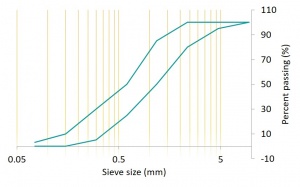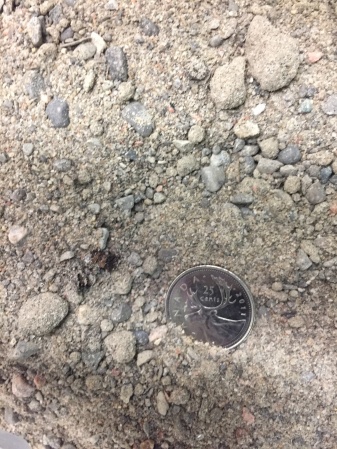Difference between revisions of "Bioretention: Filter media"
Jenny Hill (talk | contribs) |
Jenny Hill (talk | contribs) |
||
| Line 22: | Line 22: | ||
<tr><td>Coconut coir</td><td>Doesn't leach P</td><td>Requires importation</td></tr> | <tr><td>Coconut coir</td><td>Doesn't leach P</td><td>Requires importation</td></tr> | ||
<tr><td>Sphagnum peat moss</td><td>Doesn't leach P</td><td>May not be a sustainble building material</td></tr> | <tr><td>Sphagnum peat moss</td><td>Doesn't leach P</td><td>May not be a sustainble building material</td></tr> | ||
| − | <tr><td>Doesn't leach P <br>Promotes nitrogen removal from water</td><td>TBD</td></tr> | + | <tr><td>Wood chip</td><td>Doesn't leach P <br>Promotes nitrogen removal from water</td><td>TBD</td></tr> |
</table> | </table> | ||
Revision as of 16:46, 28 July 2017
Filter media should be obtained premixed from a vendor and meet all municipal, provincial and federal environmental standards. Mixing of sand, topsoil and compost should be done in a manner that preserves topsoil peds. The mixture should be free of stones, stumps, roots, or other debris larger than 50 mm diameter. Samples of the filter media should be dried, ground and tested to ensure they meet the following specifications:
It is recommended that the mixture comprises:
- 70-80 % coarse sand
- 10-15 % top soil
- 10-15 % organic soil component
Sand[edit]
- Coarse sand for LID construction shall be washed clean and free of toxic materials.
- The pH of the sand shall be ≤ 7.0.
- The coarse sand shall have a fineness modulus index between 2.8 and 3.1 according to ASTM C33/C33M, or otherwise meet the gradation below.
| Sieve | Percent passing |
|---|---|
| 9.5 mm | 100 |
| 4.75 mm (No.4) | 95 - 100 |
| 2.36 mm (No.8) | 80 - 100 |
| 1.18 mm (No.16) | 50 - 85 |
| 0.60 mm (No.30) | 25 - 50 |
| 0.30 mm (No.50) | 5 - 30 |
| 0.15 mm (No.100) | 0 - 10 |
| 0.075 mm (No.200) | ≤ 3 |
Topsoil[edit]
- Topsoil may be material that was stripped from the project site and stored in stockpiles for re-use, or material imported to the site from a supplier provided the physical and chemical characteristics are within acceptable ranges.
- Topsoil shall be in compliance with Ontario Regulation 153/04 Record of Site Condition standards for soil quality or as amended through Ontario Management of Excess Soil - A Guide for Best Management Practices.
- Soil laboratory reports shall certify the material to be suitable for re-use on residential, parkland, institutional, industrial, commercial, or community landscapes for the germination of seeds and the support of vegetative growth.
The factors to consider in determining if a topsoil is suitable for use as planting soil for a vegetated stormwater practice, or use in producing a bioretention filter media mixture include the following:
- Must be friable and capable of sustaining vigorous plant growth;
- Must be free from toxic material and roots, stones or debris over 50 mm (2") in diameter;
- Should not have been passed through sieves or screens smaller than 50 mm (2”) to avoid eliminating peds;
- Should have a Loamy Sand, Sandy Loam, Sandy Clay Loam, Loam or Silty Loam soil texture;
- For use as planting soil for a vegetated stormwater practice , the topsoil must contain a minimum of 5% organic matter by dry weight or be amended so, through addition of an organic soil conditioner;
- For use in producing bioretention filter media Blend B (water quality treatment priority), the topsoil must contain at least 9%, and not greater than 36% clay-sized particles and at least 2% organic matter by dry weight.
- Must have a pH of between 6.0 and 8.0;
- Must have a sodium absorption ratio less than 15;
- Must have a cationic exchange capacity greater than 10 milliequivalents per 100 grams (meq/100 g).
Specify that 4 litre samples of topsoil, from each source to be drawn upon, be provided to the consultant for visual inspection, along with topsoil quality test results from an accredited soil testing laboratory, or a quality assurance certificate from the supplier.
We recommend a planting soil or filter media depth of 300 mm to support grasses, 600 mm for shrubs and perennials, and 1000 mm for trees.
Organic soil amendments[edit]
Compost
Compost is the most widely used organic component. It's use in bioretention facilities is well established and documented. Low-phosphorus composts should always be sought for use in low impact development facilities including bioretention. These are typically created from feedstocks including yard, leaf, and wood waste, and must exclude manures, biosolids, and food scraps.[1]
Even low-phosphorous composts are known to export phosphorous over many years. The use of compost is not recommended in watersheds for which phosphorous pollution is a concern. There are three alternatives which have undergone field study, each of which has a number of benefits and potential concerns:
| Material | Benefits | Concerns |
|---|---|---|
| Coconut coir | Doesn't leach P | Requires importation |
| Sphagnum peat moss | Doesn't leach P | May not be a sustainble building material |
| Wood chip | Doesn't leach P Promotes nitrogen removal from water | TBD |
Coconut coir http://www.modularwetlands.com/new/wp-content/uploads/2015/11/2-Bioretention-Synthesis-2015-DAhearn.pdf
Sphagnum peat http://peatmoss.com/
Wood derivatives https://www.unh.edu/unhsc/sites/default/files/media/unhsc_bsm_spec_2-28-17_0.pdf
- ↑ Hurley S, Shrestha P, Cording A. Nutrient Leaching from Compost: Implications for Bioretention and Other Green Stormwater Infrastructure. J Sustain Water Built Environ. 2017;3(3):4017006. doi:10.1061/JSWBAY.0000821.

